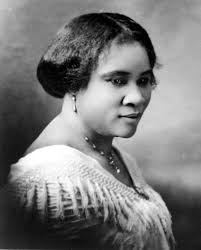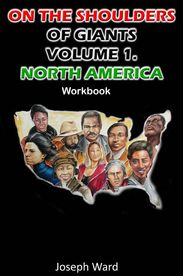|
On December 27th, 1867, Sarah Breedlove was born to parents Owen and Minerva Anderson Breedlove near Delta, Louisiana. Her parents were born slaves and still resided on a cotton plantation; year’s later Walker would be born on the same plantation as both of her parents. Walker was the Breedlove’s fifth child and the first to be born free from slavery. Her mother died in 1872 and her father would die a few years later leaving Walker as an orphan by the age of seven. She moved to Vicksburg, Mississippi to live with her sister Louvinia where she became a domestic worker and picked cotton to make money. She married Mr. Moses McWilliams at the age of fourteen to escape the abuse she endured from Jesse Powell, her brother-in-law. Walker and McWilliams had one daughter named A’Lelia Walker who was born in 1885. Two years later Moses McWilliams would die, Walker then moved to St. Louis with her four brothers who were barbers. Walker was able to send her daughter to the city’s public school by Working as a washerwoman for $1.50 a day; she also attended the public night school to further her education. Walker was being exposed to more of what the world has to offer by becoming affiliated with the women who attended St. Paul A.M.E. Church and the National Association of Colored Women. She would marry her second husband Mr. John Davis in 1894, but would leave him in 1903 before moving to Denver, Colorado in 1905. Before her move, Walker would have hair loss due to a disorder with her scalp. Searching for a remedy led her to meeting Annie Malone, an entrepreneur, founder of the Poro Institute and creator of the black hair care industry. While living in Colorado Walker worked as a sales agent for Annie Malone selling products from Malone’s Poro brand, she also would meet and marry Mr. Charles Joseph Walker a newspaperman from St. Louis. Shortly after the marriage she changed her name from Sarah Breedlove to Madame C.J. Walker. Her next step was to found her own haircare business and sold her first product the “Madame Walkers Wonderful Hair Grower,” a formula she said that come to her in a dream. Walker is known for inventing the straightening comb and the perm but Annie Malone created these products before Walker created her haircare products. Walker would travel door to door selling and promoting her products for a year and a half throughout the Southeast. In 1908 she moved to Pittsburg, Pennsylvania where she opened the Lelia College which trained her Walker “hair culturist,” or in other words her students. In 1910 she built a factory, beauty salon and school in Indianapolis, Indiana; a year later she was known nationwide for contributing $1,000 dollars to fund the building of the YMCA designated for black people in the city. In 1913 Walker expanded her business throughout the Caribbean and Central America; her daughter A’Lelia moved to New York and lived in a marvelous townhouse and operated her business out of a salon designed by black architect Vertner Tandy. Walker would move to New York in 1916 allowing Ransome and Alice Kelly to operate her company in Indianapolis. Walker operated her company out of her office in Harlem, New York where she became a socialite and beacon within her community. She would donate $5,000 to the NAACP anti-lynching movement; she also joined a group of Harlem leaders to present an anti-lynching petition to the legislation during visit to the White House. Walker’s business grew exponentially and her number of hair culturist grew so much that a Madame C.J. Walker Hair Culturist Union of America convention was created. The convention was held in 1917 and was one of the largest businesswomen conventions in the country. Walker did not allow her success or admiration for the American dream to blind her from the oppression her people faced. In a conversation about her success and racism Walker stated; “This is the greatest country under the sun, “but we must not let our love of country, our patriotic loyalty cause us to abate one whit in our protest against wrong and injustice. We should protest until the American sense of justice is so aroused that such affairs as the East St. Louis riot be forever impossible.” She would die of hypertension in 1919 at the age of 51 at her New York estate she built for herself. At her death, Walkers company was worth one million dollars and her personal net worth was around seven hundred thousand, making her one of the first women in America to become a millionaire. Walker left one-third of her estate to her daughter A’Leia; in 1927 a project she started before her death, the Walker Building opened as an African American cultural center, the Walker center is now a historic landmark. In 1998, Walker became a part of the “Black Heritage Series” by being depicted on a US postage stamp. Mrs. Walker used her knowledge, skills, will, and entrepreneurial spirit to help further change the world. She took the black haircare industry to the next level, as well as using her wealth to help protect her people from white supremacy. Madame C.J. Walker, we proudly stand on your shoulders. J.A. Ward References:
https://en.wikipedia.org/wiki/Madam_C._J._Walker https://www.biography.com/people/madam-cj-walker-9522174 http://www.madamcjwalker.com/bios/madam-c-j-walker/
0 Comments
Leave a Reply. |
Details
Categories
All
Click Here to join our mailing list
|
Contact Us: |
Connect With Us |
Site powered by PIT Web Design


 RSS Feed
RSS Feed



